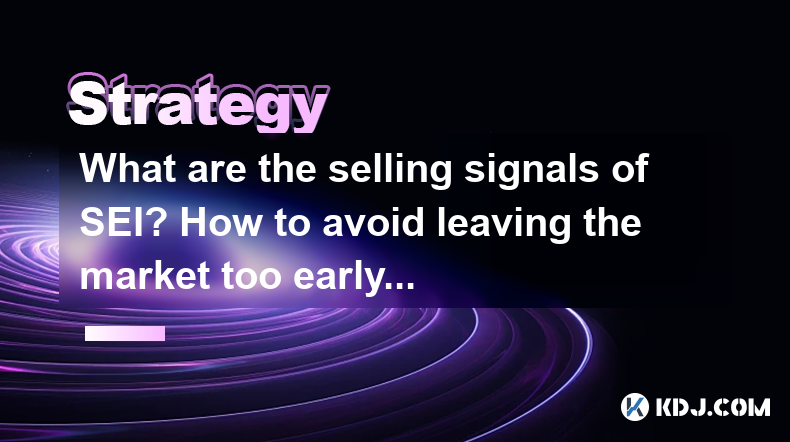-
 bitcoin
bitcoin $108842.957301 USD
-1.88% -
 ethereum
ethereum $3931.777121 USD
-1.66% -
 tether
tether $1.000186 USD
-0.03% -
 bnb
bnb $1153.250882 USD
-2.20% -
 xrp
xrp $2.367904 USD
-1.94% -
 solana
solana $186.182050 USD
-4.20% -
 usd-coin
usd-coin $0.999997 USD
0.00% -
 tron
tron $0.316949 USD
-1.00% -
 dogecoin
dogecoin $0.190780 USD
-3.12% -
 cardano
cardano $0.651324 USD
-2.67% -
 hyperliquid
hyperliquid $37.141055 USD
-0.85% -
 ethena-usde
ethena-usde $0.999224 USD
-0.09% -
 chainlink
chainlink $17.579031 USD
-2.47% -
 bitcoin-cash
bitcoin-cash $509.426284 USD
-2.79% -
 stellar
stellar $0.315298 USD
-2.93%
What are the selling signals of SEI? How to avoid leaving the market too early?
To avoid selling SEI too early, use technical indicators like moving averages and RSI, stay informed on project developments, and set clear exit points with stop-loss orders.
Apr 30, 2025 at 12:43 pm

In the volatile world of cryptocurrencies, understanding when to sell your assets is as crucial as knowing when to buy. SEI, a cryptocurrency that has garnered significant attention, is no exception. This article will delve into the key selling signals for SEI and provide strategies to avoid exiting the market prematurely.
Identifying Selling Signals for SEI
Selling signals are indicators that suggest it might be time to sell your SEI holdings. These signals can be derived from technical analysis, fundamental analysis, or market sentiment. Here are some of the most reliable selling signals for SEI:
Technical Indicators: Technical analysis involves studying price charts and using various indicators to predict future price movements. For SEI, some key technical indicators to watch include:
- Moving Averages: When the short-term moving average (e.g., 50-day MA) crosses below the long-term moving average (e.g., 200-day MA), it can signal a bearish trend.
- Relative Strength Index (RSI): An RSI above 70 indicates that SEI might be overbought, suggesting a potential sell-off.
- MACD (Moving Average Convergence Divergence): A bearish crossover in the MACD can indicate that it's time to sell.
Fundamental Analysis: This involves evaluating the underlying factors that affect SEI's value. Key fundamental indicators include:
- Project Developments: Negative news or delays in SEI's project milestones can be a signal to sell.
- Regulatory Changes: Unfavorable regulatory news affecting SEI or the broader crypto market can prompt a sell decision.
- Market Cap and Volume: A significant drop in SEI's market cap or trading volume can indicate waning interest and a potential sell signal.
Market Sentiment: The overall mood of the market can greatly influence SEI's price. Tools like social media sentiment analysis and crypto fear and greed index can help gauge market sentiment:
- Negative Sentiment: A surge in negative sentiment on social media platforms or forums can be a precursor to a price drop.
- Fear and Greed Index: A high fear index might suggest that it's time to sell before a potential market crash.
Strategies to Avoid Leaving the Market Too Early
Leaving the market too early can result in missed opportunities for further gains. Here are some strategies to help you avoid this common pitfall when trading SEI:
- Set Clear Exit Points: Before entering a trade, define your exit points based on your risk tolerance and investment goals. Use stop-loss orders to automatically sell SEI if it reaches a certain price, protecting you from significant losses.
- Use Trailing Stops: A trailing stop order adjusts the stop price at a fixed percent or dollar amount below the market price. This allows you to lock in profits while giving SEI room to grow.
- Monitor Multiple Timeframes: Analyzing SEI's price across different timeframes (e.g., daily, weekly, monthly) can provide a more comprehensive view of the market trend. This can help you avoid selling based on short-term fluctuations.
- Stay Informed: Keep up with the latest news and developments related to SEI. Being well-informed can help you make more accurate decisions about when to sell.
- Avoid Emotional Trading: Emotional decisions can lead to premature exits. Stick to your trading plan and avoid selling out of fear or greed.
Practical Steps to Implement Selling Strategies for SEI
Implementing selling strategies for SEI involves a series of practical steps. Here's how you can do it:
Analyze Technical Indicators:
- Open your trading platform and navigate to the SEI chart.
- Add the 50-day and 200-day moving averages to the chart.
- Look for a bearish crossover where the 50-day MA crosses below the 200-day MA.
- Add the RSI indicator and monitor for readings above 70.
- Add the MACD indicator and watch for bearish crossovers.
Evaluate Fundamental Factors:
- Regularly check SEI's official channels for updates on project developments.
- Stay updated on regulatory news that could impact SEI.
- Monitor SEI's market cap and trading volume on crypto market data websites.
Gauge Market Sentiment:
- Use social media monitoring tools to track sentiment around SEI.
- Check the crypto fear and greed index regularly to understand the overall market mood.
Set Up Exit Strategies:
- Determine your risk tolerance and set a stop-loss order at a price that aligns with your risk level.
- Set a trailing stop order to lock in profits while allowing for potential further gains.
- Review SEI's price across different timeframes to ensure your selling decision is not based on short-term volatility.
Stay Disciplined:
- Stick to your predefined exit points and avoid making impulsive decisions based on emotions.
- Regularly review and adjust your trading plan as needed based on new information and market conditions.
Common Mistakes to Avoid When Selling SEI
Avoiding common mistakes can significantly improve your selling strategy for SEI. Here are some pitfalls to watch out for:
- Selling Too Early: Exiting the market prematurely can lead to missed opportunities. Ensure you have a well-thought-out exit strategy and stick to it.
- Ignoring Fundamental Changes: Failing to consider fundamental changes in SEI's project or the broader market can lead to poor selling decisions. Always stay informed.
- Overreliance on Technical Indicators: While technical indicators are useful, relying solely on them without considering other factors can be risky. Use a balanced approach.
- Emotional Trading: Selling out of fear or greed can lead to suboptimal outcomes. Maintain discipline and adhere to your trading plan.
Tools and Resources for Monitoring SEI
To effectively monitor SEI and make informed selling decisions, you'll need access to the right tools and resources. Here are some essential ones:
- Trading Platforms: Platforms like Binance, Coinbase, and Kraken offer advanced charting tools and real-time data for SEI.
- Technical Analysis Software: Tools like TradingView and MetaTrader provide comprehensive technical analysis capabilities.
- Fundamental Analysis Resources: Websites like CoinMarketCap and CoinGecko offer detailed information on SEI's market cap, trading volume, and project developments.
- Sentiment Analysis Tools: Platforms like LunarCrush and Sentiment can help you gauge the sentiment around SEI on social media.
- Crypto News Websites: Stay updated with the latest news on SEI through websites like CoinDesk, CryptoSlate, and CoinTelegraph.
Frequently Asked Questions
Q: Can I use the same selling signals for other cryptocurrencies?A: While some selling signals, like technical indicators, can be applied to other cryptocurrencies, it's important to consider the unique characteristics and market dynamics of each asset. Fundamental analysis and market sentiment may vary significantly between different cryptocurrencies.
Q: How often should I review my SEI holdings?A: It's advisable to review your SEI holdings regularly, at least weekly, to stay updated on market conditions and project developments. However, during periods of high volatility, more frequent monitoring may be necessary.
Q: What should I do if I miss a selling signal for SEI?A: If you miss a selling signal, don't panic. Reassess your position based on the current market conditions and adjust your strategy accordingly. Consider setting new exit points and continue to monitor SEI closely.
Q: Is it possible to automate selling signals for SEI?A: Yes, many trading platforms and software allow you to automate selling signals using algorithms and trading bots. However, it's crucial to thoroughly test and monitor these automated systems to ensure they align with your trading strategy and risk tolerance.
Disclaimer:info@kdj.com
The information provided is not trading advice. kdj.com does not assume any responsibility for any investments made based on the information provided in this article. Cryptocurrencies are highly volatile and it is highly recommended that you invest with caution after thorough research!
If you believe that the content used on this website infringes your copyright, please contact us immediately (info@kdj.com) and we will delete it promptly.
- Crypto Markets in the Red: BTC Feels the Squeeze of Liquidity Tightening
- 2025-10-17 20:25:17
- Shiba Inu Price Prediction: Navigating Selling Pressure in the SHIB Market
- 2025-10-17 20:45:12
- Hedera, HBAR, Testnet: Navigating the Evolving Landscape in NYC Style
- 2025-10-17 21:05:13
- Unearthing Altcoin Gems Under $1: Your Q4 2025 Treasure Map
- 2025-10-17 20:45:12
- WCoin Airdrop: Scam Alert or Crypto Comeback?
- 2025-10-17 20:50:12
- XRP, Millionaire Dreams, and the Token Landscape: A New Yorker's Take
- 2025-10-17 20:25:17
Related knowledge

Practical parameter settings for a Bitcoin multi-timeframe moving average system
Sep 18,2025 at 10:54pm
Optimizing Timeframe Combinations for Bitcoin Trading1. Selecting appropriate timeframes is crucial when building a multi-timeframe moving average sys...

How can I filter out false breakouts in Dogecoin high-frequency trading?
Sep 22,2025 at 01:00am
Understanding False Breakouts in Dogecoin Trading1. A false breakout occurs when Dogecoin's price appears to move beyond a defined support or resistan...

Techniques for identifying tops and bottoms in the Bitcoin on-chain NVT model
Sep 20,2025 at 07:54pm
Understanding the NVT Model in Bitcoin Analysis1. The Network Value to Transactions (NVT) ratio is often described as the 'P/E ratio' of the cryptocur...

What does the surge in open interest in Bitcoincoin futures mean?
Sep 20,2025 at 11:18pm
Understanding the Surge in Dogecoin Futures Open Interest1. A surge in open interest within Dogecoin futures indicates a growing number of active cont...

How can I use the Ethereum USDT premium to gauge market sentiment?
Sep 18,2025 at 11:55pm
Understanding the Ethereum USDT Premium1. The Ethereum USDT premium refers to the price difference between USDT (Tether) traded on Ethereum-based plat...

What should I do if Ethereum staking yields decline?
Sep 20,2025 at 06:18am
Understanding the Causes Behind Declining Ethereum Staking Yields1. The Ethereum network transitioned to a proof-of-stake consensus mechanism with the...

Practical parameter settings for a Bitcoin multi-timeframe moving average system
Sep 18,2025 at 10:54pm
Optimizing Timeframe Combinations for Bitcoin Trading1. Selecting appropriate timeframes is crucial when building a multi-timeframe moving average sys...

How can I filter out false breakouts in Dogecoin high-frequency trading?
Sep 22,2025 at 01:00am
Understanding False Breakouts in Dogecoin Trading1. A false breakout occurs when Dogecoin's price appears to move beyond a defined support or resistan...

Techniques for identifying tops and bottoms in the Bitcoin on-chain NVT model
Sep 20,2025 at 07:54pm
Understanding the NVT Model in Bitcoin Analysis1. The Network Value to Transactions (NVT) ratio is often described as the 'P/E ratio' of the cryptocur...

What does the surge in open interest in Bitcoincoin futures mean?
Sep 20,2025 at 11:18pm
Understanding the Surge in Dogecoin Futures Open Interest1. A surge in open interest within Dogecoin futures indicates a growing number of active cont...

How can I use the Ethereum USDT premium to gauge market sentiment?
Sep 18,2025 at 11:55pm
Understanding the Ethereum USDT Premium1. The Ethereum USDT premium refers to the price difference between USDT (Tether) traded on Ethereum-based plat...

What should I do if Ethereum staking yields decline?
Sep 20,2025 at 06:18am
Understanding the Causes Behind Declining Ethereum Staking Yields1. The Ethereum network transitioned to a proof-of-stake consensus mechanism with the...
See all articles










































































